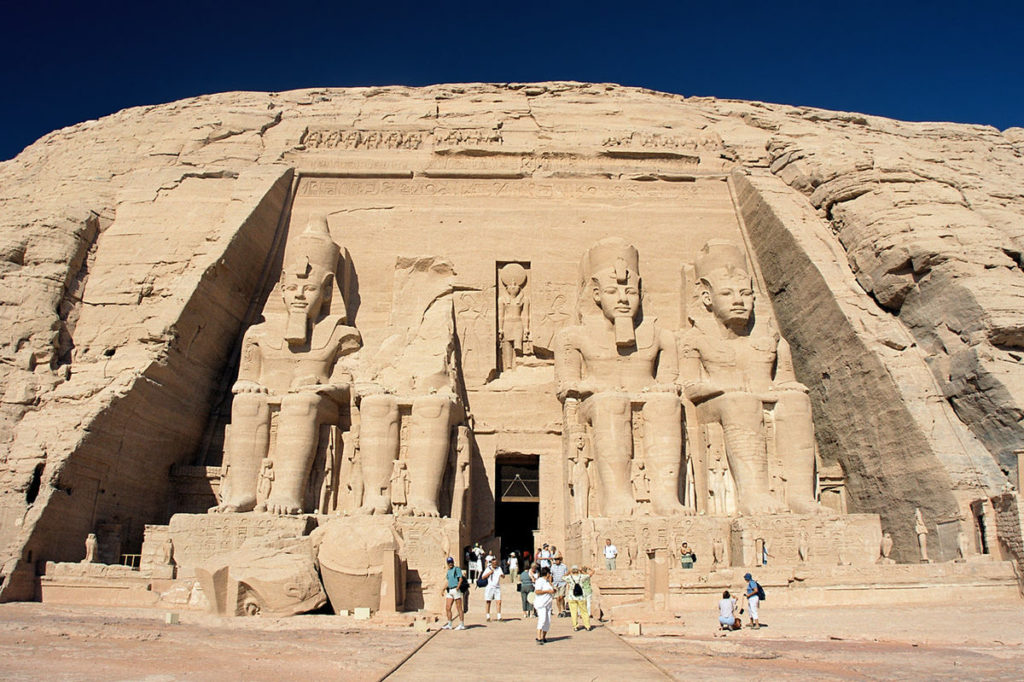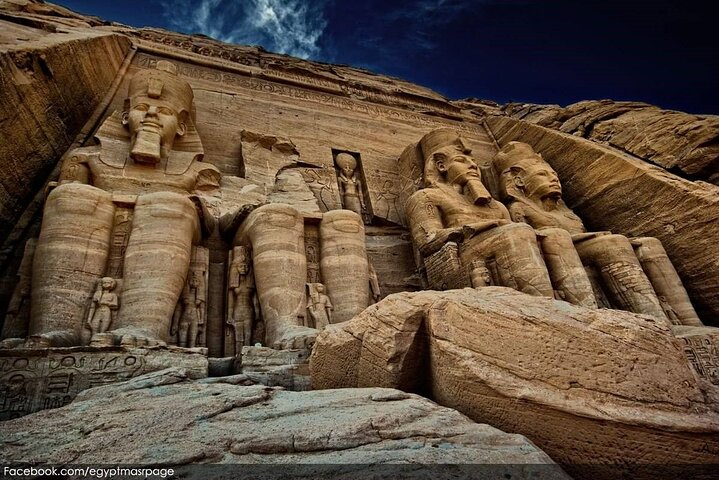Introduction: The Glory of Abu Simbel
Nestled in the golden sands of Nubia, modern-day southern Egypt, the Abu Simbel temples stand as an enduring testament to the grandeur of Pharaoh Ramesses II, one of ancient Egypt’s most illustrious rulers. Constructed in the 13th century BCE during the 19th Dynasty, these monumental temples were more than architectural marvels. They symbolized divine authority, military triumphs, and the eternal connection between the pharaoh and the gods.

The Construction of Abu Simbel
Carved into a sandstone cliff along the western bank of the Nile, Abu Simbel consists of two temples. The Great Temple was dedicated to the gods Amun-Ra, Ra-Horakhty, and Ptah. It showcases four colossal seated statues of Ramesses II, each towering 20 meters high, emphasizing the pharaoh’s godlike status. These figures are flanked by smaller carvings of his family members, illustrating their importance in his reign. The Small Temple was built in honor of Hathor and Queen Nefertari. It is one of the rare instances where a queen was depicted equal in size and prominence to the pharaoh, reflecting his admiration for his consort and devotion to the goddess of love and joy.

The temples were strategically positioned to impress both domestic audiences and foreign visitors entering Egypt from the south. The intricate carvings on their walls depict scenes from military campaigns, notably Ramesses II’s victory at the Battle of Kadesh.
Restoration and Relocation: Preserving a Legacy
In the 1960s, the construction of the Aswan High Dam threatened to submerge Abu Simbel beneath the waters of Lake Nasser. To save this invaluable heritage, an ambitious international effort led by UNESCO meticulously relocated the temples between 1964 and 1968. The temples were carefully cut into over 1,000 blocks, each weighing up to 30 tons. They were reconstructed 65 meters higher and 200 meters inland to preserve their alignment with the sun. The relocation was a landmark achievement in archaeological preservation, demonstrating global cooperation to protect humanity’s cultural treasures.

What Abu Simbel Might Have Looked Like Originally
When newly built, Abu Simbel was even more awe-inspiring. The statues and carvings were brightly painted, adding life to the sandstone’s natural hues. Its location by the Nile made it a striking visual landmark for those traveling along the river. The four colossal statues of Ramesses II at the Great Temple’s entrance stood unblemished, radiating authority and grandeur.

Cultural and Astronomical Significance
One of the most fascinating aspects of Abu Simbel is its solar alignment. On October 22 and February 22, sunlight illuminates the inner sanctuary, bathing the statues of Ra-Horakhty, Amun, and the pharaoh himself in light. These dates are believed to mark significant events in Ramesses II’s life, such as his coronation and birthday. Although the relocation shifted this alignment slightly, it still occurs with breathtaking precision.
Ongoing Mystique
Abu Simbel remains a powerful symbol of ancient Egypt’s ingenuity and artistic vision. Visitors today can still marvel at its scale and imagine its former glory. The temples not only celebrate Ramesses II’s legacy but also remind us of humanity’s enduring quest to connect with the divine and commemorate greatness.

Conclusion
From its original splendor to its remarkable preservation, Abu Simbel embodies the triumph of human creativity and resilience. This ancient site continues to captivate the world, offering a timeless window into Egypt’s golden age and the enduring legacy of Pharaoh Ramesses II. For those fortunate enough to stand before its colossal statues, Abu Simbel offers not just a glimpse into history but a profound connection to a civilization that shaped the world.

